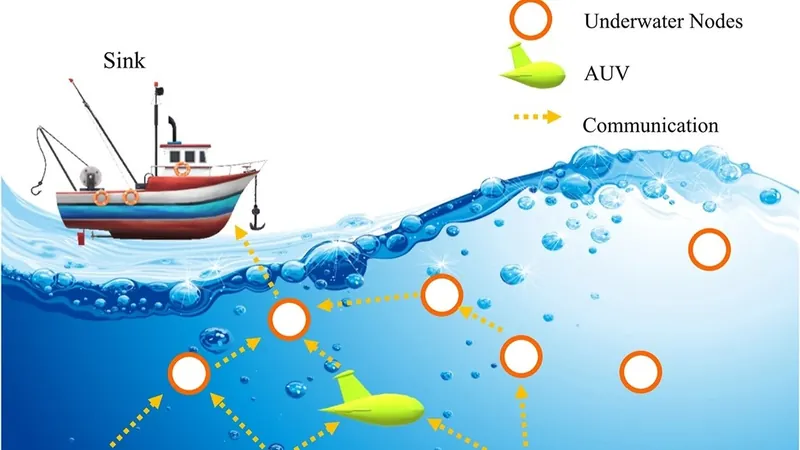
Unlocking the Depths: Pioneering Secure Underwater Communication Technologies
2025-01-04
Author: Nur
Introduction
While humanity has boldly ventured into the cosmos, our oceans remain relatively unexplored, hiding countless mysteries beneath the waves. A critical challenge faced in these submerged territories is effective communication. Unlike the vast expanses of outer space, radio signals are nearly useless in aquatic environments. Instead, we harness sound waves—the same method used by whales—to transmit information. However, this acoustic approach introduces complications such as slow data transfer rates, limited bandwidth, and high error rates, making underwater communication vulnerable to malicious attacks.
Innovative Solutions
To counter these issues, an innovative team of scientists from Chennai’s Vel Tech Rangarajan Dr. Sagunthala R&D Institute of Science and Technology and the University of Technology and Applied Sciences in Muscat, Oman, is revolutionizing underwater communications. They have developed a dual solution featuring a new routing algorithm combined with a sophisticated encryption scheme, aimed at enhancing the efficiency and security of messages transmitted underwater.
Underwater Sensor Networks (UWSNs)
At the heart of these underwater communications are Underwater Sensor Networks (UWSNs). These networks comprise nodes—sensors—and underwater vehicles that relay critical data from deep below to surface vessels. As nodes send and receive messages, they employ routing algorithms to locate their target, ensuring relayed information reaches its destination. These devices serve multiple important purposes: they monitor pollution levels, study marine ecosystems, provide early warnings of natural disasters like tsunamis, and bolster national security efforts. However, traditional devices and routing protocols face challenges like susceptibility to cyberattacks, high error rates, and substantial energy consumption.
Multipath Malicious Avoidance Routing Protocol (M2ARP) and FM-PRFES
In their latest research, the scientists introduced the Multipath Malicious Avoidance Routing Protocol (M2ARP) and FM-PRFES—an advanced Foldable Matrix-based Padding Rail Fence Encryption Scheme. Both methods significantly improve the security and efficacy of communication within UWSNs.
M2ARP enhances underwater communication by employing a multipath routing approach, ensuring better reliability and security for data transfer. Rather than relying on a single pathway—which can easily be compromised—M2ARP selects multiple routes to convey data, akin to having various detours when the primary road is blocked. This innovative method actively steers clear of nodes suspected of being targeted by malicious actors, effectively increasing the likelihood that data will reach its intended recipient unscathed.
Complementing M2ARP, FM-PRFES ensures data security through a lightweight encryption scheme. Using a foldable matrix method paired with a rail fence cipher technique, FM-PRFES shuffles the data to prevent unauthorized access or tampering. The encryption scheme is designed to minimize battery drain, a critical factor for underwater sensors that operate autonomously over extended periods. As a result, only authorized parties can decrypt and access the information, thereby preserving both confidentiality and data integrity.
Conclusion
Working in tandem, M2ARP and FM-PRFES create a robust underwater communication framework, merging energy efficiency with high security. By ensuring secure multipath routing and effective encryption measures, researchers can safely relay sensor-collected data back to central hubs, without the threat of interception or data corruption. This groundbreaking advancement not only facilitates the monitoring of oceanic changes in real-time but also empowers scientists and policymakers to make timely, informed decisions that could have a profound impact on environmental preservation and disaster management.
As research advances in this domain, the potential for these technologies could extend far beyond scientific exploration, influencing areas such as environmental protection, defense, and even search and rescue operations, thereby transforming our understanding of the deep blue world and ensuring its guardianship for future generations.

 Brasil (PT)
Brasil (PT)
 Canada (EN)
Canada (EN)
 Chile (ES)
Chile (ES)
 Česko (CS)
Česko (CS)
 대한민국 (KO)
대한민국 (KO)
 España (ES)
España (ES)
 France (FR)
France (FR)
 Hong Kong (EN)
Hong Kong (EN)
 Italia (IT)
Italia (IT)
 日本 (JA)
日本 (JA)
 Magyarország (HU)
Magyarország (HU)
 Norge (NO)
Norge (NO)
 Polska (PL)
Polska (PL)
 Schweiz (DE)
Schweiz (DE)
 Singapore (EN)
Singapore (EN)
 Sverige (SV)
Sverige (SV)
 Suomi (FI)
Suomi (FI)
 Türkiye (TR)
Türkiye (TR)
 الإمارات العربية المتحدة (AR)
الإمارات العربية المتحدة (AR)